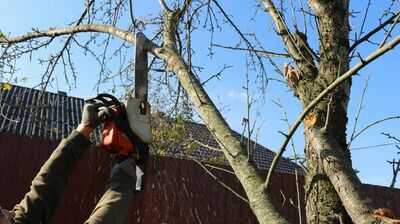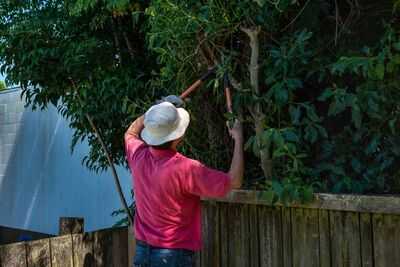
As autumn takes hold and our garden furniture is tucked away, many of us are noticing things about our gardens that we overlooked during the bustling bloom of summer.
During the sunny season, the warmth and sunshine would have spurred growth in our gardens, roadsides, and countryside, possibly leading to branches from your neighbour's tree or hedge encroaching on your space. In the summer, this might not have been a significant issue as you admired the beautiful blossoms, or you may not have noticed it at all with all the garden furniture outm and the kids playing.
However, in the stark light of autumn, you might be noticing it much more. I sought advice from experts in law and property about what could be done if a neighbour's tree began to invade my garden. They all agreed on one point.
Jagdeep Sandher, partner and head of civil litigation at Blythe Liggins Solicitors in Leamington Spa, Warwickshire, told WalesOnline: "If the tree trunk is wholly sat on the neighbour's land and the branches are overhanging on to your land, you only have a right to trim back the branches up to the boundary line, not beyond it. You can't reach into the neighbour's garden and cut them back.
"Legally, the tree is theirs, so you should offer them the branches back - if they don't want them, you're entitled to dispose of them. The best approach is to have a conversation with your neighbour before trimming the tree, to maintain neighbourly relations."
Dave Sayce, co-founder and managing director of Compare My Move, explained: "Yes, you can trim a neighbour's tree if leaves, foliage or branches are over your property boundary. You can only cut up to the boundary line, anything further can be classed as trespassing.
"You also can't enter your neighbour's land without permission to trim the tree, and you cannot damage (kill, destabilase) or fell the tree. If you do, your neighbour could be entitled to compensation from you.
"You don't have to discuss with your neighbour, by law, to trim any part of their tree that crosses your boundary line, but we recommend discussing it with them beforehand to avoid any disputes.
"The cuttings from the tree will legally belong to your neighbour, so you should discuss with them whether they want them back, however, they don't have to take them back and the responsibility of disposal will still be on you."
On the other hand, Dean Meadows, principal arboriculturist and tree risk management lead at Arbtech, clarified: "Under UK law you have the right to cut branches and roots from a neighbour's tree that encroach onto your property, without needing their permission. However, there are some important restrictions and considerations to be aware of.
"Firstly, ensure the tree isn't protected in any way. Trees in the UK may be covered by tree preservation orders (TPOs), located within conservation areas, or subject to the felling licence system, all of which require you to seek permission before carrying out any work.

"If it's not protected, you can prune branches up to the property boundary. Any further than this could be considered damage to your neighbour's property, potentially leading to legal action.
"It's important to remember that cuttings do still remain your neighbour's property and should be offered back - but never just discard them back over the fence. This could be regarded as fly-tipping of garden waste. If your neighbour declines them, responsibility for disposal then becomes yours.
"If you hire a tree surgeon to do the work, you will generally be responsible for the costs involved. In cases where the tree is causing damage due to your neighbour's negligence, you may request they cover the expenses. However, unless agreed otherwise, the cost of any work you commission typically falls on yourself."
What is the law surrounding trees and boundaries?Jagdeep Sandher explained: "It gets more complicated when trees traverse the boundary because at that point it could be a jointly owned asset so if one person wants to remove it and the other doesn't, for example, it can become a much more complex argument.
"It's also worth considering that if you have a boundary dispute with your neighbour, for example over a tree, then that's something you would have to disclose to a potential buyer if you decided to sell the house and move on - so it could have a devaluing effect on your property."
What should you do if a neighbour's tree is damaging your fence?Jagdeep advised: "The first step is to make sure you're absolutely certain that it is your fence and not theirs. The title documents for your home or previous conveyancing documents may tell you if you're unsure.
"When you're certain, I'd always advise speaking to your neighbour in a calm and collected way about it. You've always got to have in the back of your mind that you will continue living next door to this person for potentially many years to come.
"If you speak to them and the conversation isn't positive, you then need to formally set out your position in writing to the neighbour, whether you do that personally or through a solicitor."
When is it my neighbour's responsibility to cut a tree?Dave Sayce explained: "Your neighbour does not have to trim their tree if it crosses your boundary or looks bad. Your neighbour only has a responsibility to trim their tree if it becomes dangerous or is considered a nuisance, legally."

David Joyson, chief customer officer at Homeprotect, a specialist in buildings and contents insurance, stated: "It's clear that while many of us get along well with our neighbours, certain habits can still test our patience, whether it's the behaviour of pets or a perceived lack of garden maintenance.
"Issues with neighbours can cause relations to sour and create uncomfortable tension, but they can also escalate. This is why it's important to know how to de-escalate these situations, and if this can't be done, to know your legal position."
David suggests the following steps:
1. Communicate with kindness: A friendly conversation can make all the difference. Your neighbour might not be aware there's a problem or that it's causing you frustration unless you mention it to them.
2. Pick your battles: The occasional noise or minor irritations such as a noisy barbecue in the garden or differing views on garden upkeep are simply part of living in a community.
3. Avoid retaliation: Remain composed and courteous when discussing disruptive living habits with neighbours and recognise when to take the high road - you never know when you might need to depend on them in the future.
4. Know your position: If issues continue despite raising your concerns, maintain a record of what's occurring and when. This documentation can prove valuable if you need to contact your local council to report a nuisance or require legal assistance.
5. Consider your insurance options: If you find yourself in a serious dispute with your neighbours, having legal expenses cover could offer protection should the disagreement escalate to court proceedings.
You may also like

Staggered pan-India SIR likely in a week, 3 months for each phase

India Faces Crucial Matches in Women's World Cup Amidst Finishing Struggles

Chelsea star writhes in pain as horror tackle earns Ajax red card

Developing nations must unite on trade issues: Piyush Goyal

Emmerdale's mystery stowaway identity 'exposed' as Caleb gobsmacked







